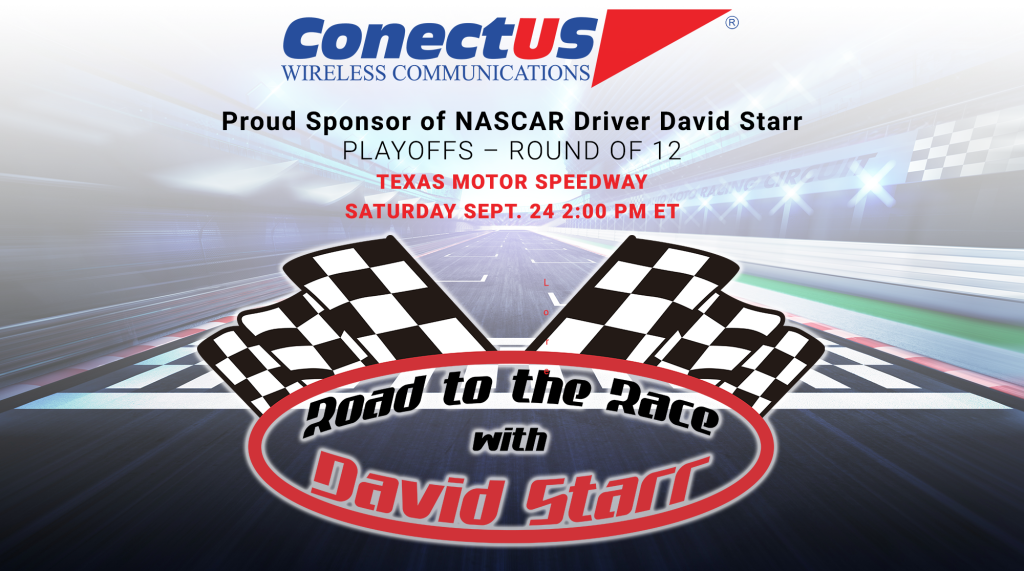I’d like to thank the gang at ConectUS Wireless for letting me write this blog about the NASCAR Busch Series, the forerunner to the Xfinity Series in which I’m competing this year.
You may have already seen interviews with Neil where I’ve mentioned Bobby Dotter’s name. From 1988-2004, Bobby drove in almost 300 NASCAR races, including the Busch Series, named for the then major sponsor Anheuser-Busch. It was then I became a big fan of Bobby, cheering him on as he moved towards the front during his races. Despite his obvious skills as a driver, he only won one Busch race in 1992.
It was at the Motor Mile Speedway in Dublin, Virginia where Bobby led the race for 58 of the 200 laps, but was passed by Jeff Burton with only seven laps to go. So it was Burton who got the confetti and champagne in Victory Lane. However, Burton’s car failed inspection, thus giving the win to Bobby, who had crossed the finishing line second.
Bobby had already left the speedway when Burton’s car was disqualified. His crew chief called him at home with the news.
Years later, Bobby told me that at first, he thought the telephone call was a prank. Then he asked himself, “Am I dreaming? This has got to be a dream. This just doesn’t happen to me.”
The Busch Series started its life in 1950 as Sportsman National Championship, NASCAR’s fourth series after the Modified Series, Roadster Series, and Strictly Stock Series of the late 1940s. The sportsman cars were not current model cars, and significant modifications were allowed. Races were typically on shorter tracks. In its first three years, 1950 to 1952, the championship was won by Mike Klapak from Warren, Ohio. The championship was won by Ralph Lee Earnhardt, father of Dale Earnhardt Sr, still greatly missed by all of us.
In 1968, the Sportsman National Championship has renamed the Late Model Sportsman Series and soon featured races on longer tracks such as Daytona International Speedway.
The current format – the one we all recognize today – was formed in 1982. However, the name was not changed until 1986 when it became the Busch Grand National Series; later just Busch Series. On February 13, 1982, the first race of the new touring series was also the first superspeedway event in the history of the series. The race was the Goody’s 300 and it was run at Daytona International Speedway. And, in an amazing coincidence, Dale Earnhardt won the race.
Over the years, the number of cars allowed on the starting grid has varied between 36 and 43.
Some NASCAR Cup Series drivers have also driven in the Busch Series races – the first typically on a Saturday, the latter the next day. Sometimes affectionately referred to as Bushwhackers, it has been suggested that they received an advantage of more practice time on the track. I can tell you from personal experience that an Xfinity car and a Cup Series car handle very differently, so there is no unfair advantage gained by participating in both races.
Despite his best efforts, after 1992 Bobby Dotter never again won a Busch Series race. It is a testament to his character and drives that he has never given up. He went on to become a team owner, competing in the Truck Series before moving to the Xfinity Series. SS-Green Light Racing found success in February when my friend Cole Custer won at Auto Club Speedway in California. He was driving SS-Green Light’s #07 Ford Mustang, the sister car to my Ford Mustang.
I feel privileged to be driving with Bobby Dotter and to be racing in the Xfinity Series, the successor to the Busch Series.
Are you interested in selling Verizon Wireless services? Call us at (855) SELL-VZW or fill out the form below. We look forward to speaking with you soon!


